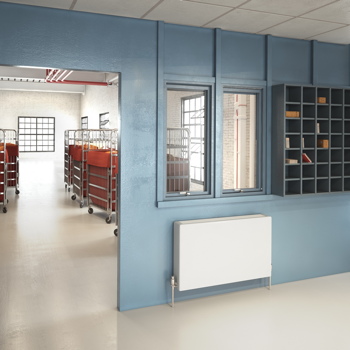Radiators respond to new commercial challenges

Radiators have a number of features that make them suited to a range of commercial applications, and recent developments enable them to provide a solution for more applications. Chris Harvey of Stelrad Radiators takes up the story.
Whilst a range of new technologies are coming into the commercial heating sector, the radiator still has a key role to play across the commercial scene — particularly in specific niche markets where traditional heating systems are still doing a good job and require an inexpensive means of sharing the heat they generate.
There is no doubt that the likes of heat pumps, VRF air-conditioning systems and chiller technology that also provide heat and, to a degree, underfloor heating are making inroads into the commercial new-build heating sector, especially in tall commercial buildings. But in the replacement market and in smaller commercial properties in particular, radiators still play an important role.
For example, the LST radiator (low surface temperature) offers an important and safe form of heat and is still popular in a wide range of commercial properties — particularly the education and healthcare marketplaces.
LSTs offer a degree of safety from radiators that are ‘safe to touch’ for people of all ages and for those who may be vulnerable. They comply with the strict requirements of the NHS Guidance Note for ‘Safe hot water and surface temperature’ and can be installed in commercial and public buildings with total public safety assured. The surface temperature of these LSTs will never exceed 43°C.
 |
| LST radiators and covered pipework ensure that exposed surfaces in this communal room of a sheltered sheltered scheme in Wales stay at a safe temperature. |
LSTs have a casing that surrounds the heat emitter and allows the heat to convect in the normal way whilst ensuring that the temperature of the casing at no time exceeds 43°C. With Stelrad LST radiators, the casing covers the radiator and also the incoming pipework, ensuring that all the heated surfaces are concealed and that any exposed surfaces stay at a safe temperature. They also come with tamperproof casings so that the safety of the radiator cannot be compromised. LSTs are the safe solution in hospitals, care and nursing homes, doctors and dental surgeries, as well as universities, colleges, schools, nurseries. They are increasingly being specified for sheltered accommodation of all kinds.
We have also seen wide interest for commercial opportunities with the Radical serial-feed radiator, particularly as a replacement radiator. The way water flows through the Radical offers significant energy savings over a traditional parallel feed radiator, and it comes with an integrated thermostatic valve insert.
Standard double-panel radiators are parallel feed; the water enters the radiator and is fed via a T piece to enter both panels at the same time and the same rate.
A serial-feed radiator allows the water to flow into the front panel first and then through the back panel.
Because the front panel of a Radical radiator heats up first, it is hotter than the front panel of a standard double-panel radiator. In addition, less heat is lost from the back panel. The front panel gives off more radiant heat — increasing the feeling of comfort. The simple result is that people feel warmer, faster. With Radical radiators, energy saving can be up to 10.5%, as tested by KIWA in a dynamic state.
 |
| Using 2 mm steel instead of 1.2 mm makes these flat-fronted radiators robust enough for Royal Mail sorting offices. |
Another use for radiators in commercial properties is illustrated by Stelrad recently being approached by the Royal Mail when it was looking for radiators that were more robust than normal and able to withstand the heavier use and potential collision of sorting-office vehicles with their trailers heading up and down corridors in the buildings. Royal Mail was taken with the flat-fronted Planar design but wanted something a little stronger. Stelrad responded by developing the Planar HD (heavy duty) which meets the needs of the Royal Mail perfectly. Using 2 mm steel instead of the standard 1.2 mm, the new model withstands even heavy contact and is attracting interest from specifiers for a range of similar applications as a result.
Another customer requested Stelrad’s input for an application where the radiators would be used in an area of high humidity — not the greatest environment for steel radiators. We responded by developing the Compact XP range of radiators — a range that is galvanised The Compact XP is suitable for use in health clubs, spa centres and swimming pools, and in niche applications such as tropical houses in zoos and garden centres.
So the suggested demise of the radiator in commercial heating is very premature. Whilst it is true that new technology is becoming the norm in high-rise, new-build commercial environments, the humble radiator is actually far from humble in a wide range of niche areas where its flexibility still provides a sensible answer to sharing heat.
Chris Harvey is marketing manager with Stelrad Radiators.







